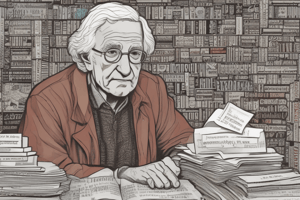Podcast
Questions and Answers
What is the name of the first step to convert a CFL grammar to CNF?
What is the name of the first step to convert a CFL grammar to CNF?
Arrange that all bodies of length 2 or more to consist only of variables.
What is the goal of the second step to convert a CFL grammar to Chomsky Normal Form (CNF)?
What is the goal of the second step to convert a CFL grammar to Chomsky Normal Form (CNF)?
Break bodies of length 3 or more into a cascade of productions, each with a body consisting of two variables.
What are the three preliminary simplifications for converting a context-free grammar to Chomsky Normal Form (CNF)?
What are the three preliminary simplifications for converting a context-free grammar to Chomsky Normal Form (CNF)?
- Reduce useless productions, Reduce epsilon productions, Reduce unit productions
- Eliminate empty productions, Eliminate unit productions, Eliminate useless symbols (correct)
- Eliminate useless symbols, Eliminate ε productions, Eliminate unit productions (correct)
- Eliminate ε productions, Eliminate unit productions, Eliminate Useless Symbols
- Remove useless symbols, Remove ε-productions, Remove unit productions
In the context of a grammar, unit productions are essential for generating the language.
In the context of a grammar, unit productions are essential for generating the language.
A grammar is considered to be in Chomsky Normal Form (CNF) if all productions are in the form A -> BC or A -> a, where A, B, and C are non-terminal symbols, and a is a terminal symbol.
A grammar is considered to be in Chomsky Normal Form (CNF) if all productions are in the form A -> BC or A -> a, where A, B, and C are non-terminal symbols, and a is a terminal symbol.
Describe the concept of 'generating' a symbol in the context of eliminating useless symbols.
Describe the concept of 'generating' a symbol in the context of eliminating useless symbols.
Explain the concept of 'reachable' symbol in the context of eliminating useless symbols.
Explain the concept of 'reachable' symbol in the context of eliminating useless symbols.
What is the difference between generating and reachable symbols?
What is the difference between generating and reachable symbols?
The order in which useless symbols are removed (first non-reachable, then non-generating) is crucial and cannot be reversed.
The order in which useless symbols are removed (first non-reachable, then non-generating) is crucial and cannot be reversed.
A grammar is in Chomsky Normal Form if it has no unit productions.
A grammar is in Chomsky Normal Form if it has no unit productions.
What is a unit production?
What is a unit production?
What are the final steps involved in converting a CFL grammar to Chomsky Normal Form (CNF)?
What are the final steps involved in converting a CFL grammar to Chomsky Normal Form (CNF)?
A grammar in Chomsky Normal Form (CNF) has productions only in the format A → BC or A → a.
A grammar in Chomsky Normal Form (CNF) has productions only in the format A → BC or A → a.
What is the central idea behind converting a CFL grammar to Chomsky Normal Form (CNF)?
What is the central idea behind converting a CFL grammar to Chomsky Normal Form (CNF)?
A context-free grammar is in Greibach Normal Form (GNF) if all productions are in the form A → aX, where A is a non-terminal symbol, a is a terminal symbol, and X is a sequence of (possibly empty) non-terminal symbols.
A context-free grammar is in Greibach Normal Form (GNF) if all productions are in the form A → aX, where A is a non-terminal symbol, a is a terminal symbol, and X is a sequence of (possibly empty) non-terminal symbols.
What is the key difference in format between Chomsky Normal Form (CNF) and Greibach Normal Form (GNF)?
What is the key difference in format between Chomsky Normal Form (CNF) and Greibach Normal Form (GNF)?
The Chomsky Normal Form (CNF) can be used as a starting point for the CYK parsing algorithm.
The Chomsky Normal Form (CNF) can be used as a starting point for the CYK parsing algorithm.
What is a derivation tree in the context of parsing a grammar?
What is a derivation tree in the context of parsing a grammar?
A derivation tree in a Chomsky Normal Form (CNF) grammar is a binary tree.
A derivation tree in a Chomsky Normal Form (CNF) grammar is a binary tree.
Any string of length 'n' in a grammar in Greibach Normal Form (GNF) can be derived in exactly 'n' steps.
Any string of length 'n' in a grammar in Greibach Normal Form (GNF) can be derived in exactly 'n' steps.
Grammars in normal form (CNF or GNF) can facilitate the process of proving properties related to languages generated by the grammar.
Grammars in normal form (CNF or GNF) can facilitate the process of proving properties related to languages generated by the grammar.
The Chomsky Normal Form (CNF) removes all the productions in a grammar that have ε symbols in their body.
The Chomsky Normal Form (CNF) removes all the productions in a grammar that have ε symbols in their body.
Flashcards
String
String
A sequence of characters, often used to represent text or code.
Grammar
Grammar
A formal system that defines the syntax of a language.
Context-free grammar (CFG)
Context-free grammar (CFG)
A grammar is context-free if the left-hand side of each production rule consists of a single non-terminal symbol.
Nullable variable
Nullable variable
Signup and view all the flashcards
Unit production
Unit production
Signup and view all the flashcards
Chomsky Normal Form (CNF)
Chomsky Normal Form (CNF)
Signup and view all the flashcards
Greibach Normal Form (GNF)
Greibach Normal Form (GNF)
Signup and view all the flashcards
Reachable symbol
Reachable symbol
Signup and view all the flashcards
Generating symbol
Generating symbol
Signup and view all the flashcards
Useful symbol
Useful symbol
Signup and view all the flashcards
Eliminate non-generating symbols
Eliminate non-generating symbols
Signup and view all the flashcards
Eliminate non-reachable symbols
Eliminate non-reachable symbols
Signup and view all the flashcards
Eliminate ε productions
Eliminate ε productions
Signup and view all the flashcards
Start symbol standardization
Start symbol standardization
Signup and view all the flashcards
Terminal symbol standardization
Terminal symbol standardization
Signup and view all the flashcards
Eliminate unit productions
Eliminate unit productions
Signup and view all the flashcards
Body decomposition
Body decomposition
Signup and view all the flashcards
Terminal extraction
Terminal extraction
Signup and view all the flashcards
Eliminate left-recursion
Eliminate left-recursion
Signup and view all the flashcards
Derivation
Derivation
Signup and view all the flashcards
Derivation tree
Derivation tree
Signup and view all the flashcards
Formal language theory
Formal language theory
Signup and view all the flashcards
Conversion to Chomsky Normal Form
Conversion to Chomsky Normal Form
Signup and view all the flashcards
Conversion to Greibach Normal Form
Conversion to Greibach Normal Form
Signup and view all the flashcards
Rule combination
Rule combination
Signup and view all the flashcards
Grammar optimization
Grammar optimization
Signup and view all the flashcards
Grammar verification
Grammar verification
Signup and view all the flashcards
Grammar rules
Grammar rules
Signup and view all the flashcards
Study Notes
CSE322 Normal Forms: CNF & GNF
- The lecture covers Chomsky Normal Form (CNF) and Greibach Normal Form (GNF) for context-free grammars.
- A presentation outline includes introduction, Chomsky normal form, preliminary simplifications, final steps, Greibach Normal Form, algorithm example, and summary.
- A grammar is defined as G = (V, T, P, S), where:
- V is a set of variables.
- T is a set of terminals.
- P is a set of productions.
- S is the start symbol.
- An example grammar is provided, with terminals T = {a, b}, variables V = {A, B, C}, start symbol S, and production P = S → A.
- A grammar example illustrates how a grammar generates strings, such as L = {anbncn | n ≥ 1}.
- Context-free grammar: the head of any production contains only one non-terminal symbol. -Example S→P; P→aPb; P→ε; L = {anbn | n ≥ 0}
- Chomsky Normal Form: all productions are either A → BC or A → a, where A, B, and C are non-terminal symbols and a is a terminal symbol.
- Preliminary simplifications for CNF include eliminating useless symbols, ε productions, and unit productions.
- Useless symbols are identified by generating and reachable symbols. A symbol is generating if it can derive a terminal string. A symbol is reachable if it can be derived from the start symbol.
- ε productions are productions that produce the empty string.
- Create two versions of the production, one with the nullable variable and one without.
- Eliminate productions with empty bodies.
- Unit productions are productions of the form A → B where A and B are variables.
- Identify unit pairs
- Replace every occurrence of B with ω.
- Steps to convert a grammar to CNF:
- Arrange all bodies of length 2 or more to consist only of variables.
- Break bodies of length 3 or more into a cascade of productions, each with a body consisting of two variables.
- Greibach Normal Form: all productions are of the form A → aX, where A is a non-terminal symbol, a is a terminal symbol, and X is a sequence of non-terminal symbols (possibly empty).
- Example of removing non-generating and non-reachable symbols are given.
- Steps for finding generating and reachable symbols.
- Examples for ε productions and unit productions are shown.
- Summary of the properties of CNF and GNF, including how derivation trees are structured, how string lengths relate to derivation steps, and how normal forms facilitate proofs.
Studying That Suits You
Use AI to generate personalized quizzes and flashcards to suit your learning preferences.




